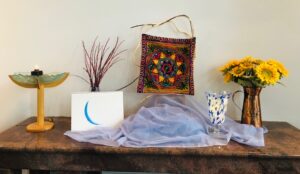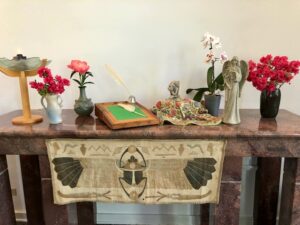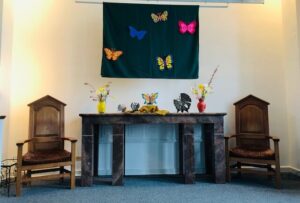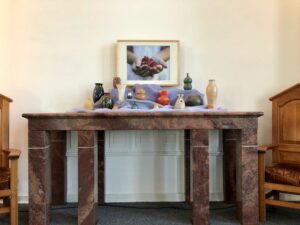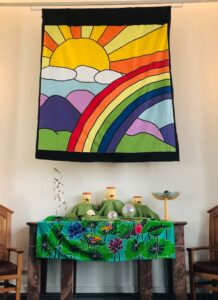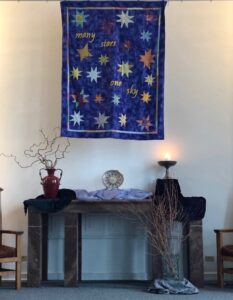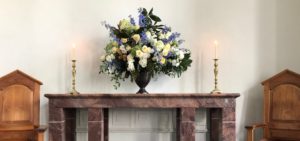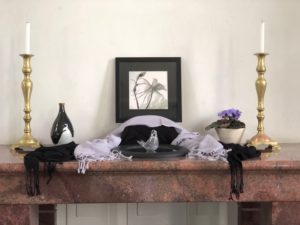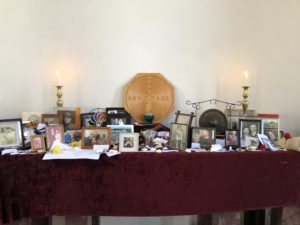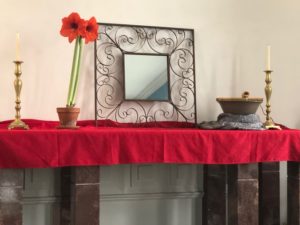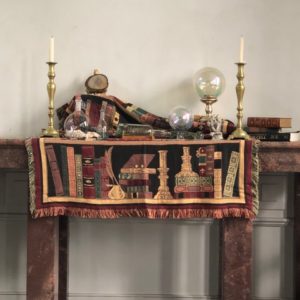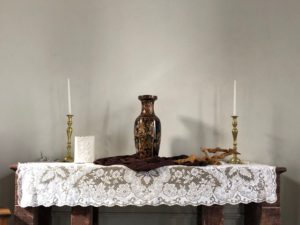Read the Order of Service
Worship for April 2016: “What does it mean to be a people of creation?”
Please note: April is designated as “Jazz Appreciation Month,” so make sure to appreciate our own jazz master, Scott DeVeaux!
April 10th: Creativity is a power that we can learn to harness for the good of the wider society. Instead of feeling overwhelmed by crisis in the world, we can know our connection to a universal source of energy. Rev. Alex McGee will be
preaching. Kermit the Frog will be Worship Weaver. Note: the choir will be singing.
“Four Walls and a Gift to the World”
by Rev. Alexandra McGee
for Thomas Jefferson Memorial Church Unitarian Universalist
for April 10, 2016
Two weeks ago, a memorial service was held at our church for a Paul Revell. Paul was not a member of our congregation, but had been attending the Harrisonburg Fellowship, which does not contract with a clergy person, and has a meeting room that seats about 100 people. Paul was not yet retirement age, and worked in Charlottesville at the Department of Forestry, where he had won the hearts of colleagues all over the state. Many people wanted to come together to honor Paul. Our member, Frank Dukes, suggested that our church, which seats 200, would be large enough to hold the many people who would be coming from around the state to honor Paul. As the family and guests arrived, so many of them gazed around and said, “Your church is beautiful.” “Wow, what a great building.” “Oh, I’ve never been here before.” Perhaps the blooming trees and flowers helped, but no doubt, it is true, our facilities, built in the 1950s, updated in the 1990s, and renovated last year, made an impression on these people.
The same thing happened two weeks ago when we hosted the memorial for Virginia Barber. Her husband, Ed, began attending worship here a few years ago, while Virginia, herself, on Sunday mornings would take rides in the countryside with a friend. She was a well-known literary agent, and people from all over the east coast wanted to come and pay their respects. The family chose our church for the memorial. Again, the people who came from all over the country commented on how nice this church is.
Six years ago, the first time I officiated a memorial and people commented admiringly on the building, I said, “Thank you.” This time, after seeing six years of seeing pledge drives, and many work parties, I said something different. I said, “Yes, our members work hard to make this building nice.” And, “Yes, our facilities committee worked hard for this upgrade.” And, “I am impressed with how the members take care of this place.”
Now, my friends, I am not just wanting you to know you provide a place for meaningful events for people you will never meet. I want you to know something else, too. They see the Black Lives Matter sign. They see the banner supporting Marriage Equality. They see the Transgender bathroom signs. They see the words of Thomas Jefferson in the foyer, and the posters naming our struggle with the legacy of Thomas Jefferson as slaveowner. They see our bulletin boards full of photos of groups events, people together, social gatherings, young and old together, community outreach. The see other messages on our walls that communicate freedom of thought, open-mindedness, and love. And I will tell you what—not one memorial service goes by when someone doesn’t come up to me at the reception and say, “I live in another town, but when I get home, I am going to look for a UU church there. I am so excited to know something like this exists. I need this.” My friends—that is Good News! That is evangelism. That is spreading hope. That is planting seeds.
So, our theology is made concrete in these bricks and mortar. By the fact of having four walls, something powerful is possible. We have space here. But something happens here that makes that space powerful.
I would like to read to you from a book published this year, called Constructive Feminism, written by a woman named Daphne Spain, a professor of Urban and Environmental Planning here at the University of Virginia. She writes: “Space is an abstract concept lacking materiality or meaning. Space becomes a place only when it is filled with people, cultural practices, objects, representations, and interpretations. Place can be described as a space that is politicized, culturally relevant, and historically specific. … The meaning and value of places can vary over time and across cultures.” (p. 14)
She goes on to look at how people who have worked against oppression have needed places to gather in order to form effective social justice movements and to bolster each other. If you consider US history, we can see that houses of worship often provided safe haven for discussion and planning. (these examples from pp.20-21)
Quakers were among the first whites to promote the abolition of slavery, and the architecture of their meeting houses lends itself to community gathering for discussion, and hence their spaces were used to organize and mobilize.
As a second example: In 1840, Elizabeth Cady Stanton was prevented from speaking at the all-male World Anti-Slavery Convention in London. Back in the United States, in 1848, she and others gathered in a Methodist chapel in Seneca Falls, New York to discuss the social, civil, and religious condition of women.
As a third example: When the civil rights movement of the 1960’s needed places to gather, they found meeting spaces in churches.
This building was built between 1950 and 1954. Because we have concrete spaces, we have power. To build a building is an act of creativity. The way we use it is a continued act of creativity.
At our church, space was used for decades for a cooperative preschool that welcomed white and black children together when local public schools were closed. For decades, our space is used for meetings of Alcoholics Anonymous. For the last few years, our space has welcomed the Vietnamese Student Association from UVA for its spring dinner and fundraiser. On the first Friday of the month, our building is the site of a food bank.
What else could we welcome into these walls?
I recently met a man who grew up in this neighborhood and remembers before this church was built. I know another man who grew up in this neighborhood and on his daily paper route as a boy would stop here to get a drink of water and use the bathroom. So, if the neighborhood had a certain shape and tenor then, what are the needs and culture of the neighborhood now? Who needs us? I drive by the apartments that are within blocks of this church. They house university students. Do those young people need the good news and the welcome that is within our walls? Do they need a positive place to gather on a Saturday night? Those are my creative questions, and I challenge you to ask those same questions of yourself and each other. In order for us to remain relevant and meaningful and live up to our values, we need to challenge ourselves to change the way we are using our space along with the changes in our town.
In Charlottesville, 14% of households speak a language other than English at home. 10% of households live under the poverty line.
(from website of gov census for Charlottesville, accessed April 8, 2016: https://www.census.gov/quickfacts/table/PST045214/51540)
In 1970, about 40 thousand people lived in Cville, and now about 46,000. At that time, 85% were white, and now 60% are white.
I apologize that I don’t have the statistics for the surrounding counties, where so many of you live.
We are at a new point in the history of our church buildings. No longer is our church basement used as a preschool. Now that renovations are complete, we have a Lower Hall which is ready for meetings and gatherings of many types. No longer do we own a house across the street used for rental housing. We have consolidated and updated. The revenue which previously came from renting to the preschool and residents is no longer on the income line of our budget.
So, what can be?
We are primed for creative responses.
We can choose who we want to invite in, who we want to be changed by. For example, already, rentals have been scheduled this summer by groups that serve children. We will hear happy singing and playing voices. What other faces and voices can help us live out our vision and mission? What rentals will make us proud?
Let us consider what role models we have in other churches. In Tulsa, Oklahoma, the UU church has 2000 members. Their vision statement declares: “A climate of profound hospitality, love, and acceptance radiates from our campus and our members.” Let me repeat that: “A climate of profound hospitality, love, and acceptance radiates from our campus and our members.” Did you hear that? Radiates. From the campus. (quoted from church website)
Another model of creativity from a very different setting is this: “The Collegiate Churches of New York City, have embarked on a joint project with a recognized developer in New York City. They plan to construct a mixed use facility of some sixty stories that will encompass both needed sacred space for their ministries and residential condominiums for the public at market prices.
Working with a developer enables the church to obtain first-rate connections in navigating the vast legal requirements of the city, while also securing advantageous financing for the project. What did the church bring to the relationship? Land. Valuable land that sits in proximity to Fifth Avenue and the Empire State Building. They will split the profits 50%-50%, and after all expenses, that will more than secure a healthy return for their church endowment.” (quoted in Alban on-line newsletter, March 24, 2016)
But urban churches are not the only ones with creative land use. Here is a story from an Episcopal church in a rural area of North Carolina. They have a proposed project for a deteriorating old barn on the land to be taken apart, board by board. High school students can be brought on field trips to learn local history and construction processes. Weathered old boards could be offered to local artists. Beams and rafters could be salvaged for adaptive re-use, made into furniture or sold to local builders for use in new construction. In its place, little cottages can be built that will help provide temporary housing for people who are in need, in collaboration with a local non-profit. They are currently working out the details of these partnerships.
ENTREPRENEURIAL MINISTRIES
All of this creativity and collaboration has a name: “entrepreneurial ministries.” Now, when you hear that, you might have a reaction about the word “entrepreneurial.” It carries different connotations for different people. But, listen to this explanation from the Rev. Lisa Fischbeck:
“We live in a time of innovation and collaboration. People, institutions and organizations are coming together to create systems and businesses that improve our environment, our democratic processes, and the lives of the poor in our communities and in our world.
Much of this work comes under the umbrella of “social entrepreneurship”. It includes a business plan that would allow for some profit, but not a lot; the motivations more for societal gain than for material gain.” (from Alban on-line newsletter, March 17, 2016)
The key words I hope you heard there were: “collaboration,” “plan” and “societal gain.”
These elements of collaboration and planning for societal gain are not only essential for sharing our physical plant, but for linking our power to other powerful movements — organizations that are already working effectively for transgender rights, immigration education, women’s access to healthcare, and many other allies who need us, and that we need to learn how to show up for more effectively.
And that is what I am challenging us to this morning. In the life of our church, we are at a point where our buildings have undergone transformation. In the cycle of our year, we are wrapping up our pledge drive. In the coming months you will see the proposed budget prepared by your board and finance committee, and in our commitment to democratic process, members of the church will vote. You are part of this creative, entrepreneurial ministry. The bricks and mortar here are part of making a gift to the world.
To steward our resources means to look not just at money but at four walls.
To steward our resources means not just what we can do for ourselves but how we can meet the needs of our community.
To be good stewards in our community means not just to answer loud voices but to listen for the quiet and unheard voices.
Unitarian Universalism is not a hierarchy in which funds and decisions come down from above. We are our own authority, in covenant with each other and other congregations, making decisions democratically. We come from the heritage of the Pilgrims—building new communities, adventuring and serving in new ways as new needs arise.
My friends, in closing — whether you listen to this message today from the perspective of a long time member and donor, or whether you are a visitor passing through just once, what I hope you take away this morning: is: the awareness of the power you have in whatever space you inhabit, and how you steward that space and share it with others. What are your most highly held values? And how will you creatively live them out, within whatever walls you find yourself?
Blessed be, Amen.
This sermon, by Alex McGee for April 10, 2016, may be shared with proper attribution.

